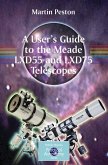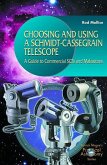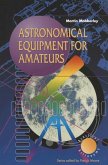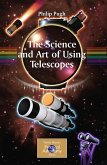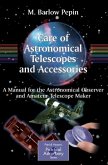This book is about using an 80mm refractor / 90mm Maksutov (such as a Helios 80 or Meade ETX90) as more than a "quick look" instrument, but rather something capable of use as an introduction to scientific observations. Emphasis is on measurement and discovery activities rather than on casual observing. There are two objectives to these activities: to re-enact the process of discovery and to provide amateur observers with the knowledge and skill that will help them make genuine contributions to the field of astronomy.
It is often said that users of small telescopes can conduct worthwhile scientific work, but 'how' is seldom explained except in the context of observations carried out by the most advanced amateur astronomers. This book provides the necessary introduction - derived from the author's many year of experience in teaching the subject - that will be the starting point for serious work.
Users will find many activities and projects suitable for an 80mm refractor or 90mm reflector or Maksutov that have not been published elsewhere.
Thesmallrefractingtelescopewithitssimpledirectdesignandconstructionand permanently aligned optics is the time tested standard for personal use. Easily portable, it can be taken out of the house and set up at a moment's notice. Or, it can be packed conveniently into a small car for traveling to a dark observing site. With moderate care and minimal maintenance, the telescope and mount canlastforgenerations. These instruments provide sharp, crisp high-contrast images of the Moon and planets. They are less susceptible to the effects of unstable air than larger ones, and because of their low maintenance and durability they are ideal for the parent educator or lifelong learner. Until recently, however, the high cost ofsmalltelescopesofsufficientqualityforseriousastronomicalusehaslimited theiraccessibility. During the past decade, innovations in optical design and manufacture have loweredcostandimprovedquality.Currentdevelopmentsinlensdesignmakeit possibletoproduceaffordablerefractingtelescopeswithshortertubelengthsand greater versatility. The once very costly 90-mm Maksutov-Cassegrain, with its optimumcombinationofeffectiveopticsandportability,nowsellsforamodest price. I have often seen small instruments referred to as "grab and go" or "quick look,"notworthyofconsiderationforseriousobserving.Imaintaintheycanbe much more. Despite their limits in types of observation, 80-mm refractors and 90-mm Maksutovs have sufficient aperture and magnifying power to provide a lifetimeofobservingpleasure.Theyareidealforlunaroccultationmeasurements, tracking the solar activity cycle, observing variable stars and measuring binary ix x Preface stars. Although all the activities described here are equally applicable to larger instruments,noneofthemrequireanaperturelargerthan80mm.Through the use of common digital cameras, the limiting stellar magnitude andimagescaleofsmalltelescopescanbeincreaseddramatically,thusproviding resultsonenormallyexpectsfromlargerinstruments.Muchofthisbookapplies thatprincipletomakinginterestingandusefulastronomicalobservations.Ihave takennovelapproachestoextendingtheuseofsmallinstrumentsforquantitative observations by applying unique methods for the analysis of digital camera photographs.
It is often said that users of small telescopes can conduct worthwhile scientific work, but 'how' is seldom explained except in the context of observations carried out by the most advanced amateur astronomers. This book provides the necessary introduction - derived from the author's many year of experience in teaching the subject - that will be the starting point for serious work.
Users will find many activities and projects suitable for an 80mm refractor or 90mm reflector or Maksutov that have not been published elsewhere.
Thesmallrefractingtelescopewithitssimpledirectdesignandconstructionand permanently aligned optics is the time tested standard for personal use. Easily portable, it can be taken out of the house and set up at a moment's notice. Or, it can be packed conveniently into a small car for traveling to a dark observing site. With moderate care and minimal maintenance, the telescope and mount canlastforgenerations. These instruments provide sharp, crisp high-contrast images of the Moon and planets. They are less susceptible to the effects of unstable air than larger ones, and because of their low maintenance and durability they are ideal for the parent educator or lifelong learner. Until recently, however, the high cost ofsmalltelescopesofsufficientqualityforseriousastronomicalusehaslimited theiraccessibility. During the past decade, innovations in optical design and manufacture have loweredcostandimprovedquality.Currentdevelopmentsinlensdesignmakeit possibletoproduceaffordablerefractingtelescopeswithshortertubelengthsand greater versatility. The once very costly 90-mm Maksutov-Cassegrain, with its optimumcombinationofeffectiveopticsandportability,nowsellsforamodest price. I have often seen small instruments referred to as "grab and go" or "quick look,"notworthyofconsiderationforseriousobserving.Imaintaintheycanbe much more. Despite their limits in types of observation, 80-mm refractors and 90-mm Maksutovs have sufficient aperture and magnifying power to provide a lifetimeofobservingpleasure.Theyareidealforlunaroccultationmeasurements, tracking the solar activity cycle, observing variable stars and measuring binary ix x Preface stars. Although all the activities described here are equally applicable to larger instruments,noneofthemrequireanaperturelargerthan80mm.Through the use of common digital cameras, the limiting stellar magnitude andimagescaleofsmalltelescopescanbeincreaseddramatically,thusproviding resultsonenormallyexpectsfromlargerinstruments.Muchofthisbookapplies thatprincipletomakinginterestingandusefulastronomicalobservations.Ihave takennovelapproachestoextendingtheuseofsmallinstrumentsforquantitative observations by applying unique methods for the analysis of digital camera photographs.
From the reviews:
"The dozens of projects collected here are a combination of observations suitable for current research (such as classifying sun-spots or monitoring binary stars) and recreating classic experiments (such as determining the speed of light by timing Jupiter's moons). ... Besides ample nuggets for science projects, a motivated amateur will gain understanding by doing the work, and ... add purpose to his or her observations." (Stuart J. Goldman, Sky & Telescope, May, 2007)
"Amateurs and students using relatively small telescopes can and do contribute useful data to many areas of astronomy. The subtitle Step-by-Step Activities for Discovery is an accurate depiction of what is provided to help novices do just that. Charts, diagrams, photographs of setups, and background information for a variety of observations are included. ... Summing Up: Recommended. General reader; lower-division undergraduates; faculty." (D. H. Gifford, CHOICE, Vol. 44 (11), August, 2007)
"The dozens of projects collected here are a combination of observations suitable for current research (such as classifying sun-spots or monitoring binary stars) and recreating classic experiments (such as determining the speed of light by timing Jupiter's moons). ... Besides ample nuggets for science projects, a motivated amateur will gain understanding by doing the work, and ... add purpose to his or her observations." (Stuart J. Goldman, Sky & Telescope, May, 2007)
"Amateurs and students using relatively small telescopes can and do contribute useful data to many areas of astronomy. The subtitle Step-by-Step Activities for Discovery is an accurate depiction of what is provided to help novices do just that. Charts, diagrams, photographs of setups, and background information for a variety of observations are included. ... Summing Up: Recommended. General reader; lower-division undergraduates; faculty." (D. H. Gifford, CHOICE, Vol. 44 (11), August, 2007)



